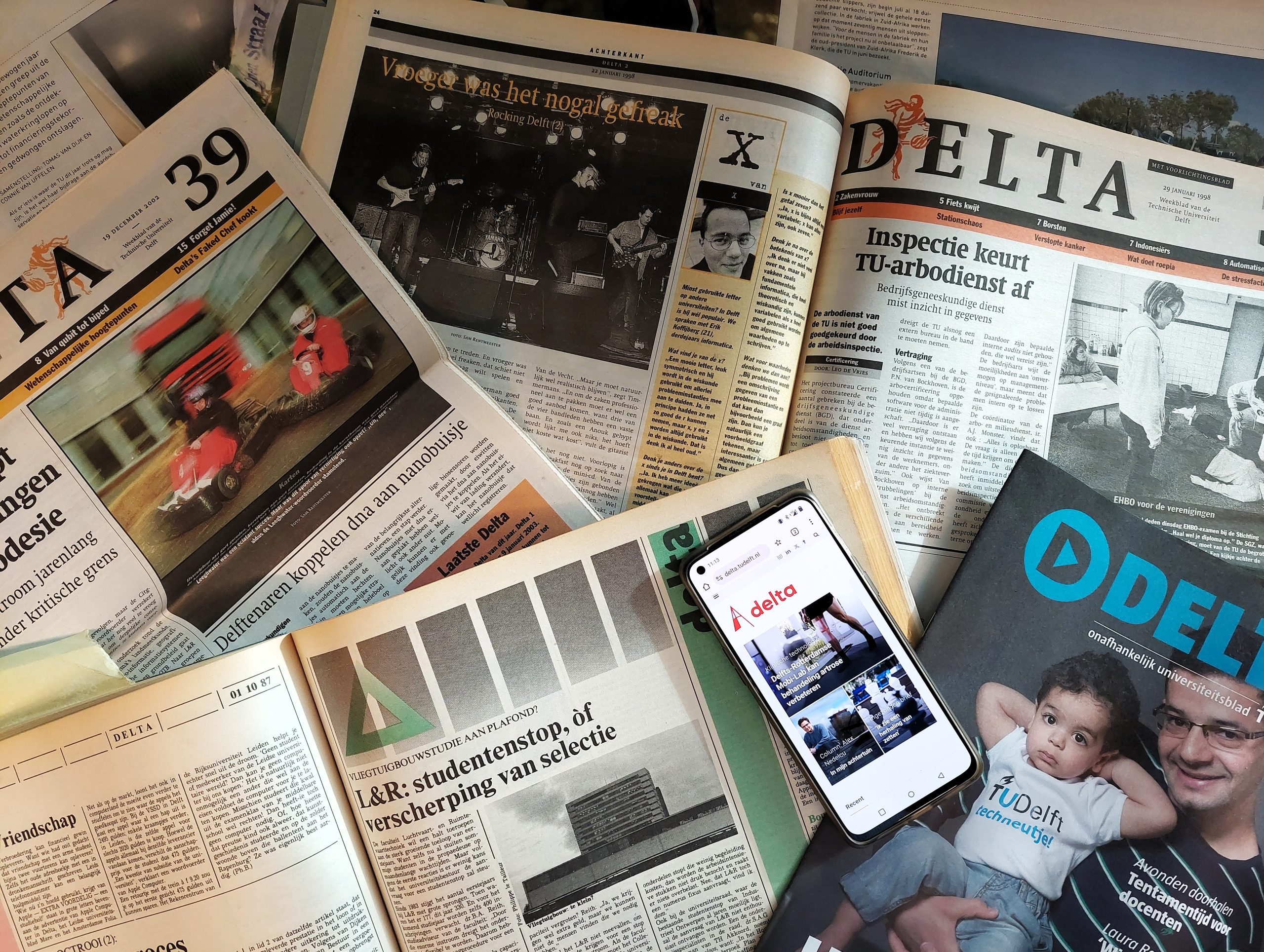A sufficient budget and a clear editorial statute are important for an independent university magazine. But good chemistry between the board and editorial team also works wonders, the book ‘De stem van de universiteit’ (The voice of the university) shows.
Delta's evolution. Paper covers from 1987, 1998, 2002 and 2016. In the middle, the Delta website on mobile. (Photo: Marjolein van der Veldt)
During the democratisation of universities in the 1970s, university bulletins evolved into more or less independent media, says a book about the university press since the late nineteenth century. A constant theme in their history is the ongoing tension between administrative interests and journalistic freedom.
The book contains contributions from various (former) editors-in-chief and historians. One of them is Abel Streefland, university historian at TU Delft. He wrote a chapter on the Delft student magazines up to 1950.
Dirty laundry
Once universities began to operate in a more business-like manner, administrators were less and less willing to guarantee editorial independence. Why pay for a magazine that aired the university’s dirty laundry?
Especially around open days, boards were extra concerned about reputation damage, writes Ries Agterberg, editor-in-chief of the Utrecht news platform DUB, in his contribution to the book. If a university magazine had a student vomiting or snorting coke on the front page, it would be reason enough to remove the entire print run from the stands – without consulting the editors. In Tilburg, this also happened because of an article about the Keuzegids in which the university got a bad score.
Lifestyle
Not only administrations, but editorial teams also changed their direction. They increasingly swapped political and administrative topics for lifestyle content, causing many newspapers to appear like a ‘glossy magazine’.
The increasing digitalisation and the decreased interest of advertisers meant that more and more magazines were only published online. The fear that this would make them less important didn’t come true, writes Agterberg. On the contrary, the different editorial teams increasingly worked together on major research articles and all of the news could now also be read outside the institution. This meant it was picked up more often by other media.
‘Simplistically critical’’
Independence remained a hotly debated issue. Guus Termeer, editor-in-chief of the University Newspaper Groningen (UKrant) between 1990 and 2004, sketches several serious conflicts at various universities in his contribution. In 2012, things suddenly went awry in Groningen, when a new executive board took office and thought the editorial team at the time was “simplistically critical”.
Following a critical opinion piece by five full professors (including later Nobel Prize winner Ben Feringa) on the appointment of scholarship PhD candidates, amongst other things, the board started to close the money tap. The magazine could only appear online from then on.
- What was the TU news in 1987? Explore decades of Delta editions in the online archive.
But Termeer also commented critically on the role of a number of editors who had supposedly engaged in ‘action journalism’: “Sometimes it seemed like editors wanted to be extra critical and pushed or even transgressed the boundaries to avoid the appearance that UKrant was a well-behaved company magazine.”
According to him, personal opinions and frustrations of board members played a role that shouldn’t be underestimated. When a completely new executive board took office in 2019, the relationship with the UKrant editorial team improved almost instantly.
For the Leiden university magazine Mare, it also made quite a difference who the president of the board was, writes university historian Pieter Slaman. “The continued existence of a critical weekly with a news function essentially depended on the willingness of that board to preserve it. Not all of the administrators were equally willing, especially when the image and income of the university were under pressure.”
Not safeguarded
Recent examples at the Eindhoven and Delft universities of technology, as well as at universities of applied sciences, demonstrate that the independence of higher education media isn’t safeguarded everywhere, far from it. The previous two ministers of Education regretted this, but weren’t willing to force the issue with the institutions.
HOP, Hein Cuppen
De stem van de universiteit. Universitaire pers sinds de late negentiende eeuw. (The voice of the university. University press since the late nineteenth century. Ab Flipse, Dorien Daling & Annelies Noordhof-Hoorn (eds.). Publisher Verloren, ISBN 9789464551204, € 22.
Do you have a question or comment about this article?
redactie@hogeronderwijspersbureau.nl


Comments are closed.